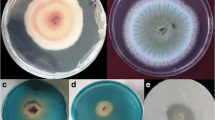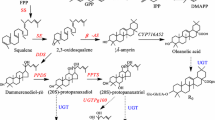Abstract
Plant growth promoting endophytic bacteria have been identified as potential growth regulators of crops. Endophytic bacterium, Sphingomonas sp. LK11, was isolated from the leaves of Tephrosia apollinea. The pure culture of Sphingomonas sp. LK11 was subjected to advance chromatographic and spectroscopic techniques to extract and isolate gibberellins (GAs). Deuterated standards of [17, 17-2H2]-GA4, [17, 17-2H2]-GA9 and [17, 17-2H2]-GA20 were used to quantify the bacterial GAs. The analysis of the culture broth of Sphingomonas sp. LK11 revealed the existence of physiologically active gibberellins (GA4: 2.97 ± 0.11 ng/ml) and inactive GA9 (0.98 ± 0.15 ng/ml) and GA20 (2.41 ± 0.23). The endophyte also produced indole acetic acid (11.23 ± 0.93 μM/ml). Tomato plants inoculated with endophytic Sphingomonas sp. LK11 showed significantly increased growth attributes (shoot length, chlorophyll contents, shoot, and root dry weights) compared to the control. This indicated that such phyto-hormones-producing strains could help in increasing crop growth.
Similar content being viewed by others
References
Adachi, M., Sako, Y., and Ishida, Y. 1996. Analysis of Alexandrium (Dinophyceae) species using sequences of the 5.8S ribosomal DNA and internal transcribed spacer regions. J. Phycol. 32, 424–432.
Ahemad, M. and Kibret, M. 2014. Mechanisms and applications of plant growth promoting rhizobacteria: Current perspective. J. King Saud Uni. Sci. 26, 1–20.
Albermann, S., Linnemannstöns, P., and Tudzynski, B. 2013. Strategies for strain improvement in Fusarium fujikuroi: overexpression and localization of key enzymes of the isoprenoid pathway and their impact on gibberellin biosynthesis. Appl. Microbiol. Biotechnol. 97, 2979–2995.
Aly, A.H., Debbab, A., Kjer, J., and Proksch, P. 2010. Fungal endophytes from higher plants: a prolific source of phytochemicals and other bioactive natural products. Fungal Div. 41, 1–16.
Ansari, M.W., Trivedi, D.K., Sahoo, R.K., Gill, S.S., and Tuteja, N. 2013. A critical review on fungi mediated plant responses with special emphasis to Piriformospora indica on improved production and protection of crops. Plant Physiol. Biochem. 70, 403–410.
Atzhorn, R., Crozier, A., Wheeler, C.T., and Sandberg, G. 1998. Production of gibberellins and indole-3-acetic acid by Rhizobium phaseoli in relation to nodulation of Phaseolus vulgaris roots. Planta 175, 532–538.
Bal, H.B., Das, S., Dangar, T.K., and Adhya, T.K. 2013. ACC deaminase and IAA producing growth promoting bacteria from the rhizosphere soil of tropical rice plants. J. Basic Microbiol. doi: 10.1002/jobm.201200445.
Barazani, O. and Friedman, J. 1999. Is IAA the major growth factor secreted from plant growth mediating bacteria. J. Chem. Ecol. 25, 2397–2406.
Bascom-Slack, C.A., Ma, C., Moore, E., Babbs, E., Fenn, K., Greene, J.S., Hann, B.D., Keehner, J., Kelley-Swift, E.G., Kembaiyan, V., and et al. 2009. Multiple, novel biologically active endophytic actinomycetes isolated from Upper Amazonian rainforests. Microb. Ecol. 58, 374–383.
Bastian, F., Cohen, A., Piccoli, P., Luna, V., Baraldi, R., and Bottini, R. 1998. Production of indole-3-acetic acid and gibberellins A1 and A3 by Acetobacter diazotrophicus and Herbaspirillum seropedicae in chemically defined media. Plant Growth Regul. 24, 7–11.
Bhore, S.J., Preveena, J., and Kandasamy, K.I. 2013. Isolation and identification of bacterial endophytes from pharmaceutical agarwood-producing Aquilaria species. Phcog. Res. 5, 134–137.
Bömke, C., Rojas, M.C., Gong, F., Hedden, P., and Tudzynski, B. 2008. Isolation and characterization of the gibberellin biosynthetic gene cluster in Sphaceloma manihoticola. Appl. Environ. Microbiol. 74, 5325–5339.
Bottini, R., Cassán, F., and Piccoli, P. 2004. Gibberellin production by bacteria and its involvement in plant growth promotion and yield increase. Appl. Microbiol. Biotechnol. 65, 497–503.
Brader, G., Stephane, C., Birgit, M., Friederike, T., and Angela, S. 2014. Metabolic potential of endophytic bacteria. Curr. Opin. Biotechnol. 27, 30–37.
Castanheira, N., Dourado, A.C., Alves, P.I., Cortés-Pallero, A.M., Delgado-Rodríguez, A.I., Prazeres, Â., Borges, N., Sánchez, C., Crespo, M.T.B., and Fareleira, P. 2014. Annual ryegrass-associated bacteria with potential for plant growth promotion. Microbiol. Res. doi. org/10.1016/j.micres.2013.12.010.
Cerny-Koening, T.A., Faust, J.E., and Rajapakse, N.C. 2004. Role of gibberellin A4 and gibberellin and biosynthesis inhibitors on flowering and stem elongation in Petunia under modified light environments. Hort. Sci. 4, 134–137.
Christina, A., Christapher, V., and Bhore, S.J. 2013. Endophytic bacteria as a source of novel antibiotics: An overview. Pharmacog. Rev. 7, 11–16.
Davicre, J.M. and Achard, P. 2013. Gibberellin signaling in plants. Development 140, 1147–1151.
Duca, D., Lorv, J., Patten, C.L., Rose, D., and Glick, B.R. 2014. Indole-3-acetic acid in plant-microbe interactions. Antonie van Leeuwenhoek doi. 10.1007/s10482-013-0095-y.
Gaiero, J.R., McCall, C.A., Thompson, K.A., Day, N.J., Best, A.S., and Dunfield, K.E. 2013. Inside the root microbiome: bacterial root endophytes and plant growth promotion. Am. J. Bot. 100, 1738–1750.
Gutierrez-Manero, F.J., Ramos-Solano, B., Probanza, A., Mehouachi, J., Tadeo, F.R., and Talon, M. 2001. The plant-growth-promoting rhizobacteria Bacillus pumilis and Bacillus licheniformis produce high amounts of physiologically active gibberellins. Physiol. Plant 111, 206–211.
Hamayun, M., Khan, S.A., Khan, A.L., Rehman, G., Sohn, E.Y., Shah, A.A., Kim, S.K., Joo, G.J., and Lee, I.J. 2009. Phoma herbarum as a new gibberellin-producing and plant growth-promoting fungus. J. Microbiol. Biotechnol. 19, 1244–1249.
Higginbotham, S.J., Arnold, A.E., Ibañez, A., Spadafora, C., Coley, P.D., and Kursar, T.A. 2013. Bioactivity of fungal endophytes as a function of endophyte taxonomy and the taxonomy and distribution of their host plants. PLoS ONE 8, e731–2.
Hilbert, M., Nostadt, R., and Zuccaro, A. 2013. Exogenous auxin affects the oxidative burst in barley roots colonized by Piriformospora indica. Plant Signal. Behav. 8, E23572/1-E23572–5.
Hussain, A. and Hasnain, S. 2011. Interactions of bacterial cytokinins and IAA in the rhizosphere may alter phytostimulatory efficiency of rhizobacteria. World J. Microbiol. Biotechnol. 27, 26–5.
Islam, M.D.R., Sultana, T., Joe, M.M., Yim, W., Cho, J.C., and Sa, T. 2013. Nitrogen-fixing bacteria with multiple plant growth-promoting activities enhance growth of tomato and red pepper. J. Basic Microbiol. 53, 1004–1015.
Jasim, B., John, C.J., Mathew, J., and Radhakrishnan, E.K. 2013. Plant growth promoting potential of endophytic bacteria isolated from Piper nigrum. Plant Growth Regul. 71, 1–11.
Joo, G.J., Kang, S.M., Hamayun, M., Kim, S.K., Na, C.I., Shin, D.H., and Lee, I.J. 2009. Burkholderia sp. KCTC 11096BP as a newly isolated gibberellin producing bacterium. J. Mcrobiol. 47, 167–171.
Joo, G.J., Kim, Y.M., Lee, I.J., Song, K.S., and Rhee, I.K. 2004. Growth promotion of red pepper plug seedlings and the production of gibberellins by Bacillus cereus, Bacillus macroides and Bacillus pumilus. Biotechnol. Lett. 26, 487–491.
Kang, S.M., Khan, A.L., Waqas, M., You, Y.H., Kim, J.H., Kim, J.G., Hamayun, M., and Lee, I.J. 2014. Plant growth-promoting rhizobacteria reduce adverse effects of salinity and osmotic stress by regulating phytohormones and antioxidants in Cucumis sativus. J. Plant Interact. doi.10.1080/17429145.2014.894587.
Khan, Z. and Doty, S.L. 2009. Characterization of bacterial endophytes of sweet potato plants. Plant Soil 322, 1–7.
Kilbane, J.J., Daram, A., Abbasian, J., and Kayser, K.J. 2002. Isolation and characterization of Sphingomonas sp. GTIN11 capable of carbazole metabolism in petroleum. Biochem. Biophys. Res. Commun. 297, 242–248.
Lata, H., Li, X.C., Silva, B., Moraes, R.M., and Halda-Alija, L. 2006. Identification of IAA-producing endophytic bacteria from micropropagated Echinacea plants using 16S rRNA sequencing. Plant Cell Tissue Organ Culture 85, 353–359.
Lee, S., Flores-Encarnacion, M., Contreras-Zentella, M., Garcia, F.L., Escamilla, J.E., and Kennedy, C. 2004. Indole-3-acetic acid biosynthesis is deficient in Gluconacetobacter diazotrophicus strains with mutations in cytochrome C biogenesis genes. J. Bacteriol. 186, 5384–5391.
Lee, I.J., Foster, K., and Morgan, P.W. 1998. Photoperiod control of gibberellin levels and flowering in sorghum. Plant Physiol. 116, 1003–1011.
Mergeay, M., Nies, D., Schlegel, H.G., Gerits, J., Charles, P., and Van Gijsegem, F. 1985. Alcaligenes eutrophus CH34 is a facultative chemolithotroph with plasmid-bound resistance to heavy metals. J. Bacteriol. 162, 328–334.
Nagata, S., Yamaji, K., Nomura, N., and Ishimoto, H. 2014. Root endophytes enhance stress-tolerance of Cicuta virosa L. growing in a mining pond of eastern Japan. Plant Speci. Biol. doi: 10.1111/1442-1984.12039.
Naveed, M., Mitter, B., Yousaf, S., Pastar, M., Afzal, M., and Sessitsch, A. 2013. The endophyte Enterobacter sp. FD17: a maize growth enhancer selected based on rigorous testing of plant beneficial traits and colonization characteristics. Biol. Ferti. Soils 50, 249–262.
Patten, C. and Glick, B. 2002. Role of Pseudomonas putida indoleacetic acid in development of the host plant root system. Appl. Environ. Microbiol. 68, 3795–3801.
Qin, S., Xing, K., Jiang, J.H., Xu, L.H., and Li, W.J. 2011. Biodiversity, bioactive natural products and biotechnological potential of plant-associated endophytic actinobacteria. Appl. Microbiol. Biotechnol. 89, 457–473.
Redman, R.S., Kim, Y.O., Woodward, C.J.D.A., Greer, C., Espino, L., Doty, S.L., and Rodriguez, R.J. 2011. Increased fitness of rice plants to abiotic stress via habitat adapted symbiosis: a strategy for mitigating impacts of climate change. PLoS ONE 6, e14823.
Ryan, R.P., Germaine, K., Franks, A., Ryan, D.J., and Dowling, D.N. 2008. Bacterial endophytes: recent developments and applications. FEMS Microbiol. Let. 278, 1–9.
Sambrook, J. and Russel, D.W. 2001. Molecular cloning, (third ed.), Cold Spring Harbor, New York, N.Y., USA.
Schulz, B. and Boyle, C. 2005. The endophytic continuum. Mycological. Res. 109, 661–686.
Selvakumar, G., Kim, K., Hu, S., and Sa, T. 2014. Effect of salinity on plants and the role of arbuscular mycorrhizal fungi and plant growth-promoting rhizobacteria in alleviation of salt stress. In Ahmad, P. and Wani, M.R. (eds.), Physiological Mechanisms and Adaptation Strategies in Plants Under Changing Environment, pp. 115–144. Springer New York, USA.
Sheng, X.F., Xia, J.J., Jiang, C.Y., He, L.Y., and Qian, M. 2008. Characterization of heavy metal-resistant endophytic bacteria from rape (Brassica napus) roots and their potential in promoting the growth and lead accumulation of rape. Environ. Poll. 156, 1164–1170.
Spaepen, S., Vanderleyden, J., and Remans, R. 2007. Indole-3-acetic acid in microbial and microorganism-plant signaling. FEMS Microbiol. Rev. 31, 425–448.
Strobel, G., Daisy, B., Castillo, U., and Harper, J. 2004. Natural products from endophytic microorganisms. J. Nat. Prod. 67, 257–268.
Supaphon, P., Phongpaichit, S., Rukachaisirikul, V., and Sakayaroj, J. 2013. Antimicrobial potential of endophytic fungi derived from three seagrass species: Cymodocea serrulata, Halophila ovalis and Thalassia hemprichii. PLoS ONE 8, e72520.
Tehler, A. 1995. Morphological data, molecular data, and total evidence in phylogenetic analysis. Can., J. Bot. 73, 667–676.
Thepsukhon, A., Choonluchanon, S., Tajima, S., Nomura, M., and Ruamrungsri, S. 2013. Identification of endophytic bacteria associated with N2 fixation and indole acetic acid synthesis as growth promoters in Curcuma alismatifolia gagnep. J. Plant Nutri. 36, 33–39.
Tivendale, N.D., Ross, J.J., and Cohen, J.D. 2014. The shifting paradigms of auxin biosynthesis. Trends Plant Sci. 19, 44–51.
Troncoso, C., González, X., Bömke, C., Tudzynski, B., Gong, F., Hedden, P., and Rojas, M.C. 2010. Gibberellin biosynthesis and gibberellin oxidase activities in Fusarium sacchari, Fusarium konzum and Fusarium subglutinans strains. Phytochem. 71, 1322–1331.
Verma, A., Kukreja, K., Pathak, D.V., Suneja, S., and Narula, N. 2001. In vitro production of plant growth regulators (PGRs) by Azorobacter chroococcum. Indian, J. Microbiol. 41, 305–307.
Weyens, N., Gielen, M., Beckers, B., Boulet, J., van der Lelie, D., Taghavi, S., Carleer, R., and Vangronsveld, J. 2014. Bacteria associated with yellow lupine grown on a metal-contaminated soil: in vitro screening and in vivo evaluation for their potential to enhance Cd phytoextraction. Plant Biol. doi: 10.1111/plb.12141.
Xu, X., van Lammeren, A.A.M., Vermeer, E., and Vreugdenhil, D. 1998. The role of gibberellin, abscisic acid, and sucrose in the regulation of potato tuber formation in vitro. Plant Physiol. 117, 575–584.
Yanni, Y.G., Rizk, R.Y., Abd El-Fattah, F.K., Squartini, A., Corich, V., Giacomini, A., de Bruijn, F., Rademaker, J., Maya-Flores, J., Ostrom, P., and et al. 2001. The beneficial plant growth-promoting association of Rhizobium leguminosarum bv. trifolii with rice roots. Aust. J. Plant Physiol. 28, 845–870.
Yu, F.B., Shan, S.D., Luo, L.P., Guan, L.B., and Qin, H. 2013. Isolation and characterization of a Sphingomonas sp. strain F-7 degrading fenvalerate and its use in bioremediation of contaminated soil. J. Environ. Sci. Health, B. 48, 198–207.
Zin, N.M., Sarmin, N.I., Ghadin, N., Basri, D.F., Sidik, N.M., Hess, W.M., and Strobel, G.A. 2007. Bioactive endophytic streptomycetes from the Malay Pensinsula. FEMS Microbiol. Lett. 274, 83–88.
Author information
Authors and Affiliations
Corresponding authors
Rights and permissions
About this article
Cite this article
Khan, A.L., Waqas, M., Kang, SM. et al. Bacterial endophyte Sphingomonas sp. LK11 produces gibberellins and IAA and promotes tomato plant growth. J Microbiol. 52, 689–695 (2014). https://doi.org/10.1007/s12275-014-4002-7
Received:
Revised:
Accepted:
Published:
Issue Date:
DOI: https://doi.org/10.1007/s12275-014-4002-7




